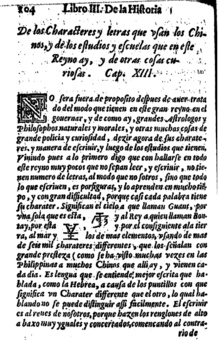Juan González de Mendoza
| Most Reverend Juan González de Mendoza | |
|---|---|
| Bishop of Popayán | |
| Church | Catholic Church |
| Diocese | Diocese of Popayán |
| In office | 1608–1618 |
| Predecessor | Juan de La Roca |
| Successor | Ambrosio Vallejo Mejía |
| Orders | |
| Consecration |
7 Jun 1593 by Filippo Spinola |
| Personal details | |
| Born |
1545 Torrecilla en Cameros (La Rioja (Spain)) |
| Died |
14 February 1618 Popayán, Colombia |
| Previous post |
Bishop of Lipari (1593–1599) Bishop of Chiapas (1607–1608) |
Juan González de Mendoza, O.S.A. (1545 - 14 February 1618) was the author of the first Western history of China to publish Chinese characters for Western delectation. Published by him in 1586, Historia de las cosas más notables, ritos y costumbres del gran reyno de la China (The History of the Great and Mighty Kingdom of China and the Situation Thereof) is an account of observations several Spanish travelers in China. An English translation by Robert Parke appeared in 1588 and was reprinted by the Hakluyt Society in two volumes, edited by Sir George T. Staunton, Bart. (London, 1853–54).
Mendoza's Historia may have been the first book-length work on China published in Europe since the days of Marco Polo. It was mostly superseded in 1615 by the work of much more informed Jesuit missionaries who actually lived in China, Matteo Ricci and Nicolas Trigault, De Christiana expeditione apud Sinas.
Biography

Mendoza was born at Torrecilla en Cameros (La Rioja (Spain)) in 1545. He joined the army but after some years resigned to enter the Order of Saint Augustine. He based his most famous text on the journals of Miguel de Luarca, whose 1580 trip to Ming China provided a simple majority thereof. He never set foot in China, but spent two years in Mexico before returning to Spain.
On 31 May 1593, he was appointed during the papacy of Pope Clement VIII as Bishop of Lipari.[3] On 7 Jun 1593, he was consecrated bishop by Filippo Spinola, Cardinal-Priest of Santa Sabina, with Cristóbal Senmanat y Robuster, Bishop of Orihuela, and Lorenzo Celsi (bishop), Bishop of Castro del Lazio, serving as co-consecrators.[3] On 24 May 1599, he resigned as Bishop of Lipari.[3] On 7 May 1607, he was appointed during the papacy of Pope Paul V as Bishop of Chiapas.[3] On 17 Nov 1608, he was appointed during the papacy of Pope Paul V as Bishop of Popayán.[3] He served as Bishop of Popayán until his death on 14 Feb 1618.[3]
Episcopal succession
While bishop, he was the principal co-consecrator of:[3]
- Pedro Castro Nero, Bishop of Lugo (1599);
- Juan Ramírez de Arellano (bishop), Bishop of Santiago de Guatemala (1600); and
- Juan Pérez de Espinosa, Bishop of Santiago de Chile (1600).
Bibliography
- Historia de las cosas más notables, ritos y costumbres del gran reyno de la China (original Spanish; Rome, 1585)
- The history of the great and mighty kingdom of China and the situation thereof (English translation by Robert Parke, 1588, in an 1853 reprint by Hakluyt Society); vol. 1 at archive.org vol. 2 at archive.org; vol. 1 at Project Gutenberg; vol. 2 at Project Gutenberg
- Links to many other translations
- Mendoza, Juan González de (1970). Staunton, Sir George Thomas, ed. The History of the Great and Mighty Kingdom of China and the Situation Thereof, Volume 1. Compiled by Juan González de Mendoza, Sir George Thomas Staunton; Contributor Sir George Thomas Staunton (reprint ed.). B. Franklin. ISBN 0833723618. Retrieved 24 April 2014.
See also
Notes
- 1 2 See footnotes to pp. 121–122 in the annotated 1853 English edition: The history of the great and mighty kingdom of China and the situation thereof
- ↑ Juan González de Mendoza (门多萨) (1998), 中华大帝国史 (Zhonghua da di guo shi) / History of the great and mighty kingdom of China and the situation thereof, 中外关系史名著译丛 (Zhong-wai guan xishi mingzhu yi cong) (Collected translations of famous works on Sino-Western relations), translated by He Gaoji (何高济), Beijing: 中华书局 (Zhonghua shu ju), ISBN 7-101-01587-5
- 1 2 3 4 5 6 7 "Bishop Juan Pedro González de Mendoza, O.S.A." Catholic-Hierarchy.org. David M. Cheney. Retrieved September 25, 2016
References
| Wikimedia Commons has media related to Historia de las cosas más notables, ritos y costumbres del gran reyno de la China. |
 This article incorporates text from a publication now in the public domain: Gilman, D. C.; Thurston, H. T.; Colby, F. M., eds. (1905). "article name needed". New International Encyclopedia (1st ed.). New York: Dodd, Mead.
This article incorporates text from a publication now in the public domain: Gilman, D. C.; Thurston, H. T.; Colby, F. M., eds. (1905). "article name needed". New International Encyclopedia (1st ed.). New York: Dodd, Mead.
External links
- Works by Juan Gonzalez de Mendoza at Project Gutenberg
- Works by or about Juan González de Mendoza at Internet Archive
| Catholic Church titles | ||
|---|---|---|
| Preceded by Martín Acuña |
Bishop of Lipari 1593–1599 |
Succeeded by Alfonso Vidal |
| Preceded by Lucas Duran |
Bishop of Chiapas 1607–1608 |
Succeeded by Juan Tomás de Blanes |
| Preceded by Juan de La Roca |
Bishop of Popayán 1608–1618 |
Succeeded by Ambrosio Vallejo Mejía |